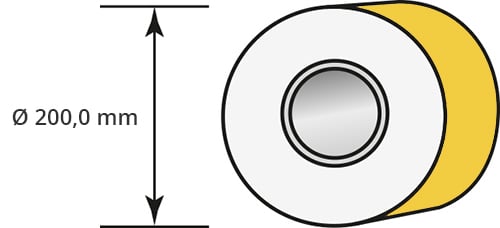Material instructions
Material ready for printing
Material instructions offset/digital printing
Download offset/digital printing instructions (PDF) ›
When submitting printable PDF materials, please check the following:
1. IMAGE RESOLUTION
Continuous-tone image resolution should follow the limits for 1:1 sized images mentioned below.
- Digital printing 200–300 ppi
- Offset 300 ppi, in art prints (stochastic rasterisation) 450 ppi
- For line art, the recommended resolution is 1,200 ppi for all printing methods.
2. BLEED MARGINS 3 MM
All materials must come with 3 mm bleed margins. Without bleed margins, there may be unwanted white areas on the edges of the printed product.
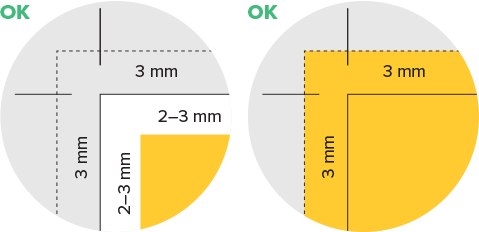
3. FONTS
- Fonts must be complete and embedded in the PDF.
- Fonts included in graphic files are most likely to work when converted into paths.
- Reverse types (white text on a coloured background) of less than 10 points must be discussed with the printer due to a possible misalignment affecting the readability of the text.
4. LINE THICKNESS
The smallest recommended line thickness is 0.25 pt. Narrow lines should not be used for multi-colour, rasterised or reverse printing.
5. COLOURS
For four-colour works, we recommend that you define the colours as process colours (CMYK), only any additional colours are defined as SPOT/PANTONE colours. For digital printing, you can also use RGB colours in the images: our default profile for RGB images is Adobe RGB. Be sure to always embed RGB and CMYK profiles in PDF files.
Our recommended CMYK colour profiles:
- coated paper: PSO Coated v3, FOGRA 51
- uncoated paper (offset only): PSO Uncoated v3, FOGRA 52
If you are using RGB materials, we recommend that you submit a layout package.
6. CREATING A PDF
Regardless of the printing method, please note the following:
- Always include cutting lines in the PDF (with a 3 mm margin)
- The material must be centred on the page
- The content must be centred on the page, all pages must have the same size and same orientation, and the pages must be in the correct order.
- When ordering sticker sheets, the content may only be the size of one sticker, and the PDF file may only contain the content of one sticker, not the entire sticker sheet.
Please note that PDF proofing and any additional work due to it will be invoiced work unless otherwise agreed.
7. OVERPRINT
Please do not use overprinting for any other partial colour than black. Ask for more information if you’d like to use overprinting for other colours.
8. FOUR-COLOUR BLACK
Please do not use four-colour black (= Registration black of layout programs).
100 % BLACK, 0/0/0/100
9. DIE CUTTING
- Materials that need to be cut into shape must have cutting lines with a spot colour named ”Cut” (line colour C0 M100 Y0 K0) and overprinting. Ask for further instructions if necessary.
- The die cutting line must be a single continuous line, not several separate pieces.
- If possible, submit the material with and without the die, making it possible to use the material with as many different printing methods as possible.
10. MATERIAL SUBMISSION
Please submit the material as agreed beforehand. We recommend that you pack the material into one .zip file.
E-mail submission
- You can submit the material by e-mail. The recommended max. size is 10 MB.
FTP submission
- Works both with a web browser and via an FTP client.
- http://transfer.grano.fi – for temporary material transfers, the user can log in with a public username. Both the username and the password are “vieras”.
- After the transfer, please notify your contact person by e-mail.
Material instructions large formats
Download large formats instructions (PDF) ›
When submitting printable PDF materials, please check the following:
1. IMAGE RESOLUTION
Continuous-tone image resolution should follow the limits for 1:1 sized images mentioned below.
- 72–150 ppi
- for photo paper, 200 ppi
- for large fabrics, 50 ppi
For line art, the recommended resolution is 1,200 ppi for all printing methods.
Sufficient image resolution
2. BLEED MARGINS 5 MM
All materials must come with 5 mm bleed margins. Without bleed margins, there may be unwanted white areas on the edges of the printed product.
- for one-sided prints: 5 mm
- for two-sided prints: 10 mm
- note: rollup materials must have a 200 mm installation margin
- Sewing margins for different post-treatment methods:
- Clean cut fabrics must have a 5 mm bleed margin.
- When the edge of the fabric is folded and sewn (hemming), please leave a 20 mm sewing margin for each edge to be sewn.
- There should also be a 20 mm sewing margin for a reinforcement band.
- Tunnel hems need a sewing margin three times the diameter of the pipe. E.g. for a 50 mm pipe, leave a 150 mm sewing margin to the material.
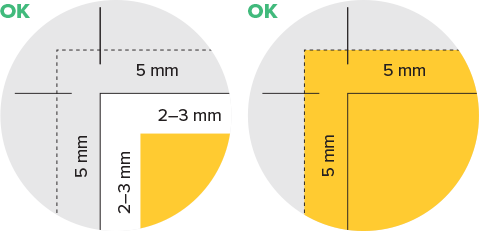
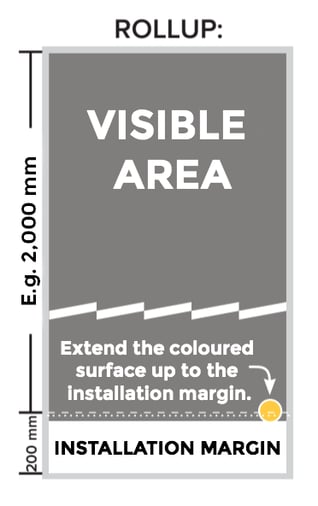
3. FONTS
- Fonts must be complete and embedded in the PDF.
- Fonts included in graphic files are most likely to work when converted into paths.
- Reverse types (white text on a coloured background) of less than 10 points must be discussed with the printer due to a possible misalignment affecting the readability of the text.
4. LINE THICKNESS
The smallest recommended line thickness is 0.25 pt. Narrow lines should not be used for multi-colour, rasterised or reverse printing.
5. COLOURS
For four-colour works, we recommend that you define the colours as process colours (CMYK), only any additional colours are defined as SPOT/PANTONE colours. For digital printing, you can also use RGB colours in the images: our default profile for RGB images is Adobe RGB. Be sure to always embed RGB and CMYK profiles in PDF files.
Our recommended CMYK colour profile:
- PSO Coated v3 (FOGRA 51)
If you are using RGB materials, we recommend that you submit a layout package.
6. CREATING A PDF
Regardless of the printing method, please note the following:
- Always include cutting lines in the PDF (with a 3 mm margin)
- The material must be centred on the page
- The material must be divided into individual pages, no double pages
- All pages must have the same size and same orientation
7. OVERPRINT
Please do not use overprinting for any other partial colour than black or, when using a white additional colour, white. Ask for more information if you’d like to use overprinting for other colours.
8. FOUR-COLOUR BLACK
Please do not use four-colour black (= Registration black of layout programs).
100 % BLACK, 0/0/0/100
9. SHAPE CUTTING
- Materials that need to be cut into shape must have cutting lines with the spot colour ”Cut” (M100) and overprinting. Ask for further instructions if necessary.
- The cutting line must be a single continuous line, not several separate pieces.
- If possible, submit the material with and without the cutting line, making it possible to use the material with as many different printing methods as possible.
10. MATERIAL SUBMISSION
Please submit the material as agreed beforehand. We recommend that you pack the material into one .zip file.
E-mail submission
- You can submit the material by e-mail. The recommended max. size is 10 MB.
FTP submission
- Works both with a web browser and via an FTP client.
- http://transfer.grano.fi – for temporary material transfers, the user can log in with a public username. Both the username and the password are “vieras”.
- After the transfer, please notify your contact person by e-mail.
Instructions for address registers
Any address data that you submit to us should be in Excel format (.xls or .xlsx). Otherwise, we will charge an additional fee for data processing/sorting.
(Professionally processed .txt and .csv files can be accepted if agreed upon separately. However, the structural requirements described below still apply.)
Please check the following before submitting Excel files:
1. CELL HEADERS
The file must include the following headers. Address Excel files should not include any other data unless absolutely necessary. The additional data must not affect the structure of the file and the data must be easily removable, if necessary, before the addresses are imported into various systems.
Headers:
(Customer No.)
Name 1
Name 2
Street address
Postal code
City
Country
2. ROWS AND COLUMNS
Each column must only contain data corresponding to the column header. In particular, the street address column must not contain any other data (such as c/o or company information!).
The customer number is mainly relevant to direct/magazine deliveries if you want to print your own customer/member numbers alongside addresses. If you do not have customer numbers, the column is not needed or can be left empty.
For company addresses, enter the name of the company in the Name 1 field and the name of the person in the Name 2 field.
For private addresses, enter the name of the recipient in the Name 1 field and any additional information/clarifications in the Name 2 field, or leave the field empty.
To display the zeroes in postal codes in Excel, format the column’s cells to display the data as text (Format Cells… -> Number -> Category: Text).
Alternatively, you can enter an apostrophe (') in front of a number, in which case Excel will treat it as text.
(Postal code and City can also be in the same column.)
If the address is in Finland, the data in the Country column is not required, otherwise it is mandatory.
(The number of columns in the register does not matter, but the structure should be as detailed above.)
3. NUMBER OF CHARACTERS
The recommended maximum number of characters is 50 characters/column, including spaces. The address printing area on a print product can also significantly limit the number of characters.
4. TABS
As a general rule, address files should not include multiple tabs.
In complex mailings involving multiple batches, for example, it is almost always clearer to divide the addresses into several files instead of using a single file with multiple tabs.
Exceptions shall be agreed upon separately with the contact person.
5. DATA SUBMISSION
Submit your data in the manner agreed upon in advance with the seller or in the quote and within the agreed upon deadline. (Usually preferably in conjunction with the print assets)
Email submission
Submitting address files via email is not recommended due to the General Data Protection Regulation (GDPR). If you cannot submit address files any other way, please use secure email (www.tietosuoja.fi).
FTP submission
Works both with a web browser and via an FTP client. https://transfer.grano.fi – for temporary data transfers, you can sign in using a guest account. Both the username and the password are “vieras”.
After the transfer, notify your contact person of the transfer by email.
Downloadable settings files
FOGRA 51
Large format printing, digital printing and coated offset printing assets
FOGRA 52
Uncoated offset printing assets
Both packages contain an ICC profile,
Job options (for PDF creation) and Adobe CC colour management settings.
Additional information about using Job options
Before you can use Grano’s Job options, you will need to install the right ICC profile on your device:
- If you want to use GRANO_PSO Coated v3 Job options, you must first install the PSO Coated v3 ICC profile on your device..
- If you want to make a PDF on uncoated paper using GRANO_PSO Uncoated v3 Job options, you must first install the PSO Uncoated v3 ICC profile on your device.
Material for layout or design work
Material for layout or design work
Download material for layout or design work (PDF) ›
What to remember when submitting material for layout or design work:
1. A SHORT VERBAL DESCRIPTION OF THE FINAL PRODUCT
Give a short but detailed description of the desired final product, its specifications, content and look.
2. MATERIAL TO BE SUBMITTED
- text (e.g. a Word file)
- images as clearly named image files (e.g. JPG, TIF)
- logos and graphic elements in a vector graphics format (e.g. AI, EPS, PDF)
- any graphic guidelines and desired colours and fonts
- any references and templates
If you are ordering revisions to be made to existing material or you want us to use a layout template, please submit an InDesign package that includes an IDML file and all the necessary links.
You can request specific fonts, but we will charge you extra if we do not already have the fonts in our selection. Generally, we do not accept fonts submitted by customers. Custom fonts are an exception to this rule, if the customer transfers the right of use to Grano.
We can also use our stock photos for an extra charge.
3. SPECIFICATIONS
- Desired final product and format (e.g. printed product, electronic PDF, display ad, newspaper/magazine ad)
- Size (width x height in millimetres, digital material in pixels)
- Scope/page count
- Colours (coloured, black-and-white, any PMS colours)
- Proof delivery address (email)
- Final product delivery method or media and delivery address
Stickers and labels
Dimensions of stickers and labels
Label size
Width is indicated before length.
E.g. 50 x 100 mm

E.g. 45 x 20 mm

Winding direction
The winding direction of a printed label roll is indicated according to the header text as 1,2, 3…8. The winding directions of blank labels are indicates as 1–4 when the labels are on the inside of the roll and as 5–8 when the labels are on the outside of the roll.

Example: Label dimensions: 50 x 75 mm, Winding direction: 2
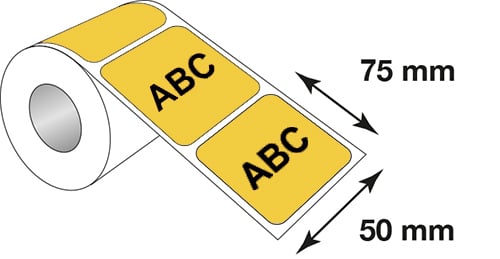
Standard internal diameters of cores
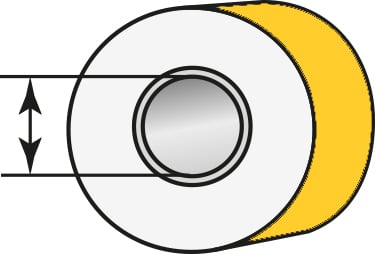
25,4 mm
38,0 mm
41,0 mm
50,0 mm
76,2 mm
101,6 mm
External diameter of the roll
E.g. Ø 200,0 mm.
External dimensions can also be indicated as labels per roll.
